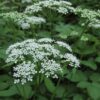Marsh Mallow (Althaea officinalis)
Flowers: Summer. Height: 120cm (48in).
Althaea comes from the Latin word ‘Altheo’, meaning ‘I cure’ and the Greek ‘Altho’ meaning ‘to heal’.
Medicinal: The plant’s medicinal use has a long history dating back over 2,000 years. Beginning around 9th century BC, the Greeks used Marsh Mallow to heal wounds and soothe sore throats. Roman doctors made a balm made from the plant’s sap which was was applied to toothache, bee stings, chilblains and irritated skin. Arabian doctors created a poultice from the leaves to treat inflammations, while Hippocrates, known as ‘the father of medicine’, used it to remedy bruises and blood loss. Physicians in medieval times used it for coughs, as a gargle for mouth and throat infections, respiratory diseases and leprosy, and to help old stubborn wounds to heal.
Culinary: Culpeper’s Complete Herbal (1653) recorded that the roots of the plant were “full of slimy juice, which being laid with water, will render it as thick as jelly” and it was used to thicken soups. It is not known exactly when marshmallows were invented, but their history goes back as early as 2000 BC. The root was ground and made into paste then roasted to make a rudimentary version of the marshmallow sweets we have now.



